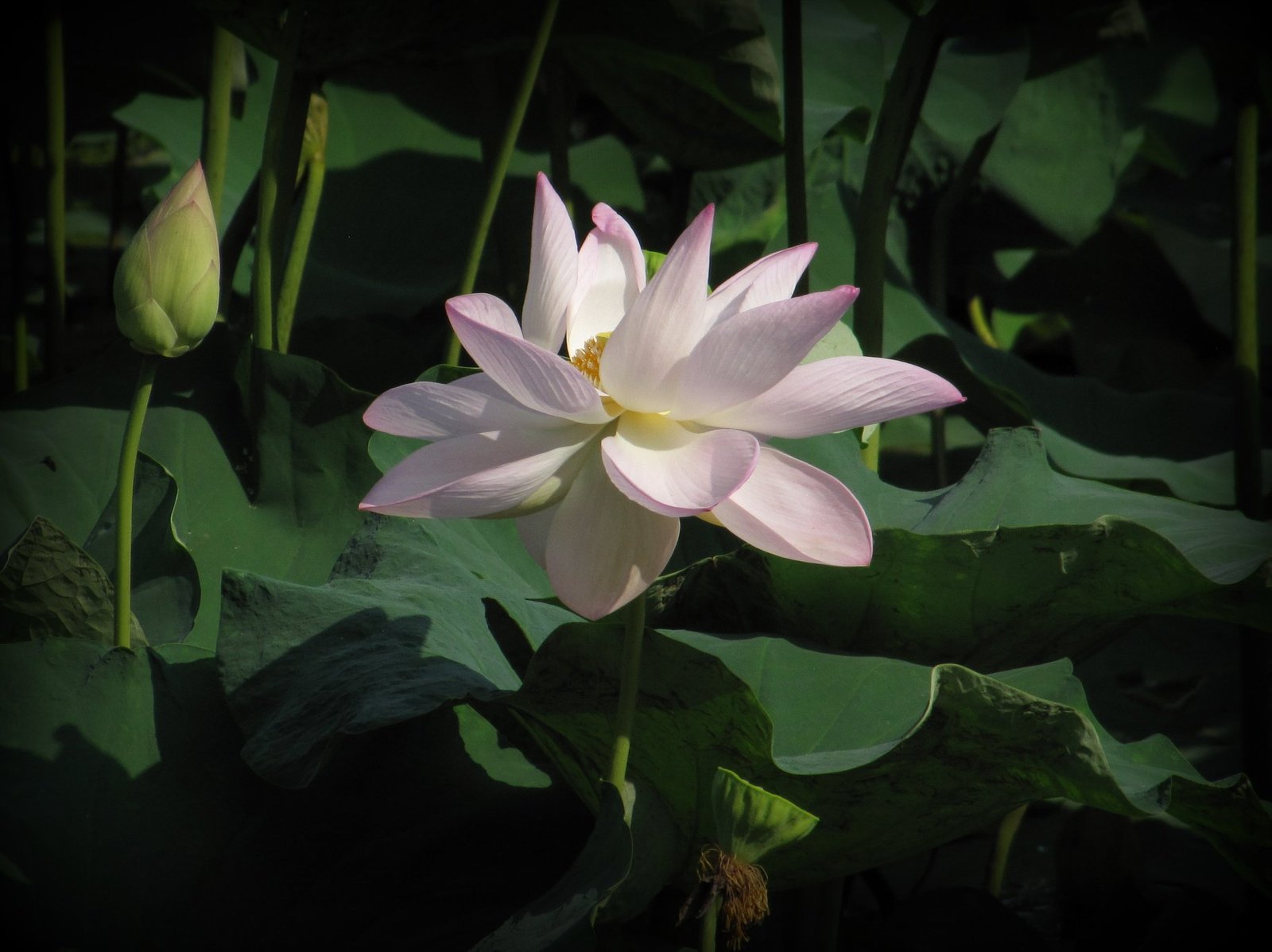
Lotus
Kṛṣṇa’s eyes, navel and face, hands and feet are like eight lotus flowers on His body. From those eight lotuses emanates a fragrance like a mixture of camphor and lotus. That is the scent associated with His body.
(CC Antya 19.94)
The Lord is described herein as lotus eyed (padma-palāśa-locanāt). When a person is fatigued, if he sees a lotus flower all his fatigue can be immediately reduced to nil. Similarly, when an aggrieved person sees the lotus face of the Supreme Personality of Godhead, immediately all his grief is reduced. A lotus flower is also an insignia in the hand of Lord Viṣṇu as well as in the hand of the goddess of fortune. The worshipers of the goddess of fortune and Lord Viṣṇu together are certainly very opulent in all respects, even in material life. The Lord is sometimes described as śiva-viriñci-nutam (SB 11.5.33), which means that Lord Śiva and Lord Brahmā also offer their respectful obeisances unto the lotus feet of the Supreme Personality of Godhead, Nārāyaṇa.
(SB 4.8.23)
The most beautiful object in the material world may be compared to the blue lotus flower or the full moon in the sky, but even the lotus flower and the moon were defeated by the beauty of the bodily features of Lord Kṛṣṇa, and this was certified by the demigods, the most beautiful living creatures in the universe.
(SB 3.2.13 purport)
If one sees a lotus flower, one can immediately remember Kṛṣṇa. For example, if one loves one’s child and one sees any of the child’s garments, or his shoes or a small ship or any of his playthings, one will immediately remember the child: “Oh, these are my child’s shoes. These are my child’s playthings. This is his garment.” This is the nature of love. So if one actually loves God, Kṛṣṇa, one can remember Him always…..
So here, in these prayers, Kuntīdevī, a great devotee, is giving us an opportunity to become Kṛṣṇa conscious simply by concentrating our mind on paṅkaja, the lotus flower. Paṅka means “mud,” and ja means “generate.” Although the lotus flower is generated from mud, it is a most important flower, and Kṛṣṇa likes it very much. Kuntīdevī therefore describes all the parts of Kṛṣṇa’s body with reference to lotus flowers, so that as soon as one sees a lotus flower one will immediately think of Kṛṣṇa: “Oh, Kṛṣṇa’s navel is just like a lotus, and from Kṛṣṇa’s navel grew the stem of the lotus upon which Brahmā, the creator of this universe, was born. This universe includes so many planets, seas, mountains, and cities with motorcars and other paraphernalia, but the entire universe began from that lotus.”……
Kṛṣṇa’s navel resembles a lotus, He is garlanded with lotuses, and His eyes are also compared to the petals of a lotus (ālola-candraka-lasad-vanamālya-vaṁśī (Brahma Samhita. 5.31). So if we simply think of only this one verse, which describes Kṛṣṇa’s body with reference to the lotus, we can meditate our whole life on how beautiful Kṛṣṇa is, how wise Kṛṣṇa is, and how Kṛṣṇa manifests His creation. This is meditation – thinking of Kṛṣṇa. Dhyānāvasthita-tad-gatena manasā paśyanti ‘yam yoginaḥ (SB 12.13.1). A yogī is one who always thinks of Kṛṣṇa.
(Teachings of Queen Kunti – Chapter 5 The Vision of Lotuses)
Arjuna addresses Lord Kṛṣṇa as “lotus-eyed” (Kṛṣṇa’s eyes appear just like the petals of a lotus flower) out of his joy, for Kṛṣṇa has assured him, in a previous chapter, ahaṁ kṛtsnasya jagataḥ prabhavaḥ pralayas tathā: “I am the source of the appearance and disappearance of this entire material manifestation.
(BG 11.2)
O lotus-eyed Lord, by concentrating one’s meditation on Your lotus feet, which are the reservoir of all existence, and by accepting those lotus feet as the boat by which to cross the ocean of nescience, one follows in the footsteps of mahājanas [great saints, sages and devotees]. By this simple process, one can cross the ocean of nescience as easily as one steps over the hoofprint of a calf.
(SB 10.2.30)
O lotus-eyed one, those who think they are liberated in this life but are without devotional service to You are of impure intelligence. Although they accept severe austerities and penances and rise to the spiritual position, to impersonal Brahman realization, they fall down again because they neglect to worship Your lotus feet.
(CC Madhya 24.131)
One’s nostrils are no better than the bellows of a blacksmith if one has not smelled the fragrance of Kṛṣṇa’s body, which is like the aroma of musk combined with that of the bluish lotus flower. Indeed, such combinations are actually defeated by the aroma of Kṛṣṇa’s body.
(CC Madhya 2.33)
My respectful obeisances are unto You, O Lord, whose abdomen is marked with a depression like a lotus flower, who are always decorated with garlands of lotus flowers, whose glance is as cool as the lotus and whose feet are engraved with lotuses.
(SB 1.8.22)
The devotees of the Lord are accustomed to licking up the honey available from the lotus feet of the Lord. What is the use of topics which simply waste one’s valuable life?
The spiritual planet, Goloka Vṛndāvana, the eternal abode of Lord Kṛṣṇa, is shaped like the whorl of a lotus flower. Even when the Lord descends to any one of the mundane planets, He does so by manifesting His own abode as it is. Thus His feet remain always on the same big whorl of the lotus flower. His feet are also as beautiful as the lotus flower. Therefore it is said that Lord Kṛṣṇa has lotus feet.
(SB 1.16.6)
The Lord’s chest is the abode of the goddess of fortune. His moonlike face is the drinking vessel for eyes which hanker after all that is beautiful. His arms are the resting places for the administrative demigods. And His lotus feet are the refuge of pure devotees who never talk or sing of any subject except His Lordship.
(SB 1.11.26)
Dear Lord, we offer our respectful obeisances unto You because from Your abdomen sprouts the lotus flower, the origin of all living entities. You are always decorated with a lotus garland, and Your feet resemble the lotus flower with all its fragrance. Your eyes are also like the petals of a lotus flower. Therefore we always offer our respectful obeisances unto You.
(SB 4.30.25)
One who performs his duty without attachment, surrendering the results unto the Supreme Lord, is unaffected by sinful action, as the lotus leaf is untouched by water.
(BG 5.10)
Gauda-mandala takes the form of a hundred-petaled lotus, with the most beautiful Navadvīpa in the center. The circumference of the central stamen of the flower, or Antardvīpa, is ten miles, and the circumference of the eight-petaled flower, or Navadvīpa, is thirty-two miles. Outside this are the hundred petals of Gauda-mandala, whose circumference measures one hundred sixty-eight miles.
(Sri Navadvipa-Dhama-Mahatmya, Pramana-Khanda, Chapter 2)



